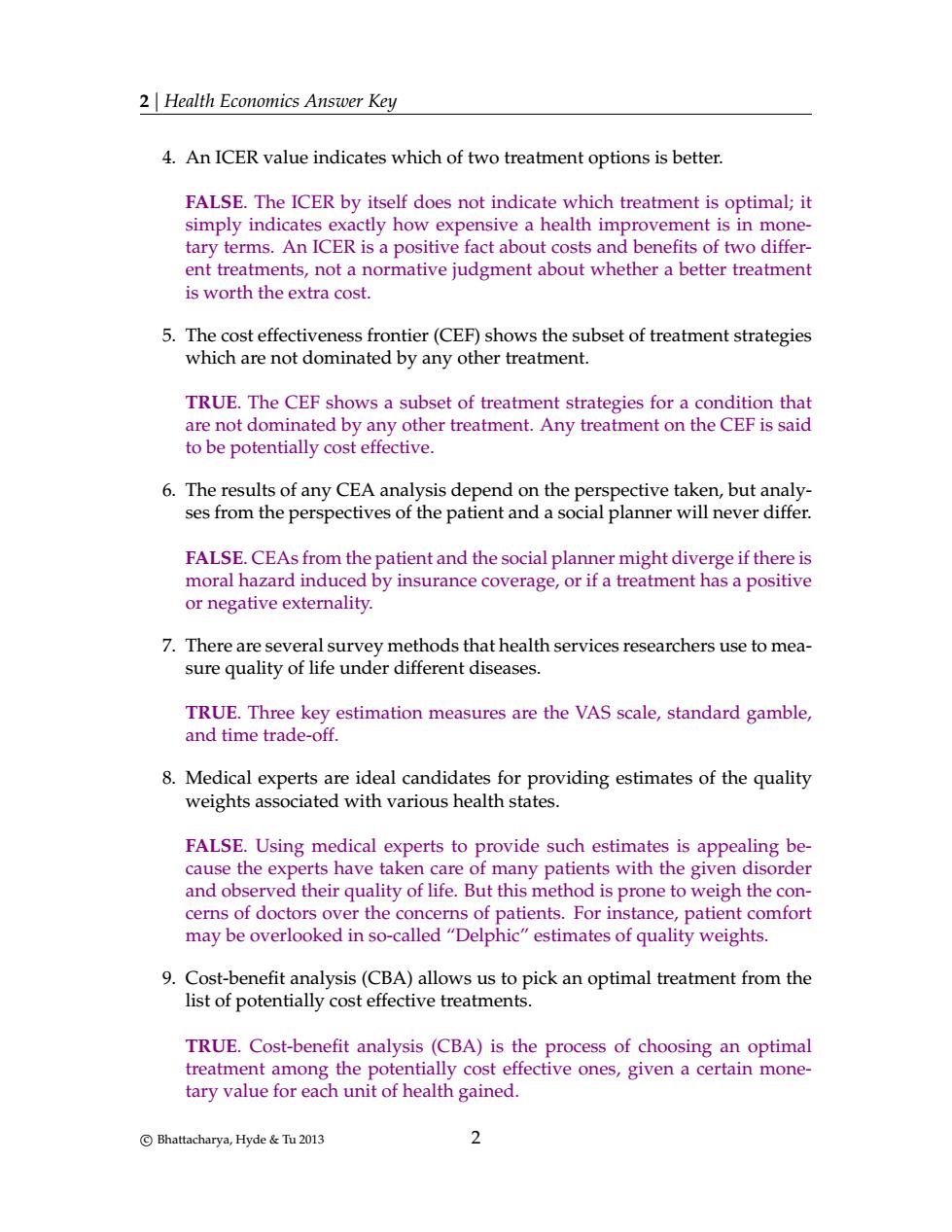正在加载图片...

2 Health Economics Answer Key 4.An ICER value indicates which of two treatment options is better FALSE The ICER by itself does not indcate wrcn treatment is optimal;it simply indicates exactly how expensive a health improvem I mone tary terms.An ICER is a positive fact about costs and benefits of two differ ent treatments,not a normative judgment about whether a better treatment is worth the extra cost. 5.The cost effectiveness frontier(CEF)shows the subset of treatment strategies which are not dominated by any other treatment. TRUE.The CEF shows a subset of treatment strategies for a condition that are not dominated by any other treatment.Any treatment on the CEF is said to be potentially cost effective. 6.The results of any CEA analysis depend on the perspective taken,but analy- ses from the perspectives of the patient and a social planner will never differ. FALSE.CEAs from the epatient and the social plann r might dive erge if there is moral hazard induced by insurance coverage,or if a treatment has a positive or negative externality. 7.There are several survey methods that health services researchers use to mea- sure quality of life under different diseases. TRUE.Three key estimation measures are the VAS scale,standard gamble and time trade-off. 8.Medical experts are ideal candidates for providing estimates of the quality weights associated with various health states. FALSE.Using medical experts to provide such estimates is appealing be- cause the experts have taken care of many patients with the given disorder and observed their quality of life.But this method is prone to weigh the con- cerns of do nt comfor 9.Cost-benefit analysis(CBA)allows us to pick an optimal treatment from the list of potentially cost effective treatments. TRUE.Cost-benefit analysis (CBA)is the process of choosing an optimal Bhattacharya,Hyde &Tu2013 22 | Health Economics Answer Key 4. An ICER value indicates which of two treatment options is better. FALSE. The ICER by itself does not indicate which treatment is optimal; it simply indicates exactly how expensive a health improvement is in monetary terms. An ICER is a positive fact about costs and benefits of two different treatments, not a normative judgment about whether a better treatment is worth the extra cost. 5. The cost effectiveness frontier (CEF) shows the subset of treatment strategies which are not dominated by any other treatment. TRUE. The CEF shows a subset of treatment strategies for a condition that are not dominated by any other treatment. Any treatment on the CEF is said to be potentially cost effective. 6. The results of any CEA analysis depend on the perspective taken, but analyses from the perspectives of the patient and a social planner will never differ. FALSE. CEAs from the patient and the social planner might diverge if there is moral hazard induced by insurance coverage, or if a treatment has a positive or negative externality. 7. There are several survey methods that health services researchers use to measure quality of life under different diseases. TRUE. Three key estimation measures are the VAS scale, standard gamble, and time trade-off. 8. Medical experts are ideal candidates for providing estimates of the quality weights associated with various health states. FALSE. Using medical experts to provide such estimates is appealing because the experts have taken care of many patients with the given disorder and observed their quality of life. But this method is prone to weigh the concerns of doctors over the concerns of patients. For instance, patient comfort may be overlooked in so-called “Delphic” estimates of quality weights. 9. Cost-benefit analysis (CBA) allows us to pick an optimal treatment from the list of potentially cost effective treatments. TRUE. Cost-benefit analysis (CBA) is the process of choosing an optimal treatment among the potentially cost effective ones, given a certain monetary value for each unit of health gained. c Bhattacharya, Hyde & Tu 2013 2